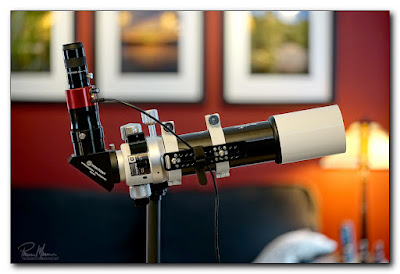An Aperture Mask

I was evaluating a new solar filter on two separate mornings over the past week. The views weren't as good as they could be. These views were brighter than necessary and my research was indicating that reducing the aperture of the telescope might produce better results. In particular, I was hoping to find a way to see more detail on the surface of the sun's chromosphere. I always have some scrap lumber lying around so I went looking for a small scrap of 1/4" plywood. I could cut a hole of the correct size and then cut out the outside diameter. This would then fit inside the dew shield on my telescope. The inside hole would provide the new, smaller aperture for the telescope. In this case, my intention was to cut a 60mm hole. Unfortunately, the drill bit walked a bit when cutting so I screwed up the hole slightly. Fortunately, I managed to salvage the project by making the hole a 63mm diameter hole instead. This would change my...


